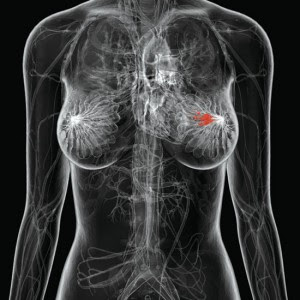Abstract
Breast cancer is a common malignant neoplastic disease in women and mostly develops in the stage of women postmenopausal.
Introduction
Breast cancer is the most disseminated cancer disease and a primary cause of death among women. Though, a substantial number of younger women are grievously affected, commonly in families with a hereditary susceptibility of the pathogen.
Researches proved that the death rates of patient’s suffering from breast cancer are decreasing because of the application of extensive screening mammography, earlier diagnosis, and advancement in the adjuvant treatment. In effect, modern monotonous clinical management of breast cancer depend on a number of clinical and pathological signs and predictive factors and these appear inadequate to reflect the whole clinical heterogeneousness of tumors and are perfectly adjusted to each patient.
Estrogens
Cancer of the breast is a multifaceted genetic disease marked by the natural growth of multiple molecular changes. It is a genotypically, phenotypically, and clinically a heterogeneous, complex disease. Furthermore, Estrogens are steroid hormones that perform vital roles in the growth and development of the mammary gland. In addition, estrogens significantly contribute to breast carcinogenesis (Anthony, & Jack, 2012). For example, women treated with estrogen diethylstilbestrol have a significantly increased risk of developing breast cancer.
Fillmore et al. (2010) noted that it is well demonstrated that the expansion of breast cancer cell lines in culture or ovariectomized nude mice is stimulated by estrogens. Thus, estrogens are associated with normal cell growth, and also breast cancer cell growth which bring about the development of this disease.
Pathophysiology
Cancer of the breast is the consequence of the developmental process of different environmental, hereditary, and individual factors. From the pathophysiology viewpoint, some of the instant primary reasons for the unexpected appearance of breast cancer include: Injuries and other destruction to DNA often caused by genetic alterations, failure of the white blood cells to eliminate cancerous cells, malfunctioning development factor in the method of breast cell sectionalization and growth, and lastly hereditary defects in genetic factor that usually repair deoxyribonucleic acid destruction, including injury which may cause cancer of the breast (Shi , 2012).
The pathophysiology of cancer of the breast begins in standard breast cells, which unexpectedly turn out to be cancerous due to the change in the systematized manner that cells develop, split, and correct themselves.

The existing understanding of breast cancer is that disturbing (invasive) cancers occurs through chains of molecular changes at the cellular stage. This causes the gradual beginning and spread of breast epithelial tissue with remarkable features and irrepressible growth (Arnold, 2012).
Basic Types
Breast cancer can be categorized as invasive (Infiltrating) and noninvasive (in situ). Invasive cancers develop into the typical aggregate of cells in the breast and later spread outside the epithelial duct. In contrast, noninvasive cancers can grow into or increase the possibility for a more severe, invasive cancer. Another category of noninvasive breast cancer is Ductal carcinoma in situ (DCIS) (Arnold, 2012). A normal duct consists of a layer of normal cells. During ductal hyperplasia the number of ducts increases and many of these ducts become enlarged (cysts), but cells still remain in a single layer. In atypical hyperplasia, a lumen is still present, but the nuclei become irregular and multiple cell layers form, during DCIS multiple lumens form to give a crib-form presentation.
Invasive ductal cancer (IDC) consists of nests of epithelial cells surrounded by extra cellular matrix. IDC displays the invasive side of cancer of the breast. Through this invasion, invasive ductal cancer spreads through the basement membrane of the breast tissue.
Treatment of breast cancer
Diverse kinds of treatments and diagnosis are accessible for patients with cancer of the breast, depending on the stage of the illness during diagnosis. In a clinical setting, breast cancer is diagnosed with a “triple test” of medical breast checkup, and by the use of X-rays.
- Surgery: the most widely used treatment of localized breast cancer is either breast conserving surgery and radiation therapy or mastectomy (Arnold, 2012).
- Radiation therapy: throughout radiation therapy, high-powered x-rays or different radiations assists in eliminating the basic structural and functional units of cancer or restraining them from developing.
- Chemotherapy: this is a treatment for breast cancer with the aid of drug intended to destroy microscopic implants of cell that is part of a malignant tumor either by terminating the cells or by preventing them from separating.
- Hormone therapy: this cure for breast cancer eliminates endocrines or stops their act and discontinues the multiplying of cancer cells.
Reference List
Anthony, H., & Jack, C. (2012). Oestrogen and breast cancer: results from the WHI trial. The Lancet Oncology, Volume 13, Issue 5, Pages 437 – 438. Web.
Arnold, W. (2012). CDC: “Breast Cancer Treatment.” Web.
Fillmore, C. M., Gupta, P. B., Rudnick, J. A., Caballero, S., Keller, P. J., Lander, E. S., and Kuperwasser, C. (2010). Estrogen expands breast cancer stem-like cells through paracrine FGF/Tbx3 signaling. PNAS 107: 21737-21742.
Ridoscoot, 2011. Pathophysiology of Breast Cancer. Web.
Shi, Yi. (2012). Control Inflammation To Prevent Cancer Development.